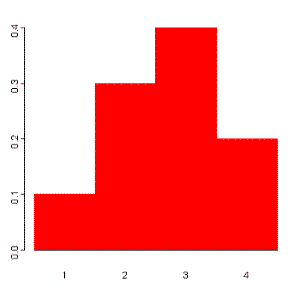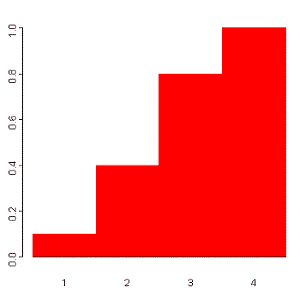Distributions and Densities
Probability Distribution
The probability distribution of a discrete random variable is a list of probabilities associated with each of its possible values. It is also sometimes called the probability function or the probability mass function.
Example
 Suppose a variable X can take the values 1, 2, 3, or 4.
Suppose a variable X can take the values 1, 2, 3, or 4.
Let the probability that X=1 be 1/10,
the probability that X=2 be 3/10,
the probability that X=3 be 4/10, and
the probability that X=4 be 2/10.
This distribution has the graphical representation shown to the right:
Cumulative Distribution Function
All random variables (discrete and continuous) have a cumulative distribution function. It is a function giving the probability that the random variable X is less than or equal to x, for every value x.
For a discrete random variable, the cumulative distribution function is found by summing up the probabilities.
Example
 The cumulative distribution function for the above probability distribution is calculated as follows:
The cumulative distribution function for the above probability distribution is calculated as follows:
The probability that X is less than or equal to 1 is 1/10,
the probability that X is less than or equal to 2 is 1/10+3/10 = 4/10,
the probability that X is less than or equal to 3 is 1/10+3/10+4/10 = 8/10, and
the probability that X is less than or equal to 4 is 10/10 = 1.
The graphical representation for this function is shown to the right:
(Definitions taken from Valerie J. Easton and John H. McColl's
Statistics Glossary v1.1)
 Suppose a variable X can take the values 1, 2, 3, or 4.
Suppose a variable X can take the values 1, 2, 3, or 4.
 The cumulative distribution function for the above probability distribution is calculated as follows:
The cumulative distribution function for the above probability distribution is calculated as follows: